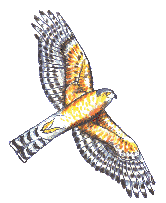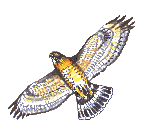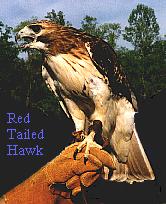
Sharp-Shinned Hawk
| WEATHER | | | CALENDARS | | | ADVENTURES | | | TRAVELS | | | MUSIC | | | COUPONS | | | BOOKS | | |
|
|||||
|
|
|||||||||||||||||||
 Sharp-Shinned Hawk |
Already in August, the Broad-Winged hawks will begin their movements south to their wintering grounds in the tropics. Broad-Winged hawks are "buteos", large, thick-set hawks, with broad wings and rounded tails. Because of their size, the buteos like to take advantage of air movements to ease their long journey, and Broad-Winged hawks in particular are known for their use of the thermal air currents.
Basically there are two types of air currents that migrants use to speed themselves along their way--Thermal currents and deflective currents. Thermal currents are columns of rising air that are produced on calm, sunny days where the sun heats the air faster than in surrounding areas. Heated air rises into the atmoshere, eventually cooling and losing its ability to hold water vapor and forming cumulus clouds. The upward movement of the air is strong enough to lift all kinds of things-- like water vapor, dust and leaves, or hawks (with a little help from the hawk itself). The other type of air current is a deflective current and is the product of wind flowing up and over an obstruction, like water over a boulder in a creek. Because thermal currents are dependant on solar heating on calm days, they are more likely to occur in late spring, summer and early fall. As the days shorten, the potential for thermal production tapers off in the fall. As low pressure centers begin to roll out of Canada into the US dragging cold fronts behind, the deflective currents become the more predominant sort. In the Appalachians, a cold fronts' passage will usually bring clearing skies and winds from the north or northwest that will strike the mountains and the wind will be forced up and over. Since the ridge of the appalachians runs from the northeast to a southwest direction, there is also a tendency for the air to have a southerly motion to it as well that migrants use to their advantage.
|
 Broad-Winged Hawk |
As the days cool and cold fronts start pushing farther south in October, the deflective wind currents start to become more predominant. Deflective currents are better suited to the "accipiters", long-tailed woodland hawks with rounded wings, chiefly the Sharp-Shinned and the more rare Cooper's Hawks. The accipiters are more streamlined to allow greater manueverability in their woodland homes.
The optimal deflective wind uplift occurs close to the mountain ridge line and rock outcroppings and cliffs provide the best viewing. The hawks that utilize these currents are more solitary and don't form large flocks as the Broad-Winged hawks do, nevertheless, if you find the right spot, you may still see large numbers of hawks in a short time, flying quickly just above the tree tops. Deflected air currents provide propulsion as well as lift to the hawks and they can average a flight speed of 40 miles per hour. Sharp-Shinned Hawks are rather small hawks, 10-14 inches long and they fly with several quick beats and then a sail. They are distinguished from the slightly larger Cooper's hawk by their square-tipped tail.

Towards the end of October, Red-tailed hawks become more numerous as migrants. The Red-Tails are buteos, but nevertheless utilize the deflective currents becasue by the time their migration begins thermal production has been decreased through shortened days and cooler temperatures. The Red-Tailed migration continues into November and they may be accompanied by Red-Shouldered Hawks, Northern Harriers and occassional Peregrine Falcons. Northern Goshawks and rare Golden Eagles are more likely to be seen in November after the leaves have fallen.
We've gathered some more information about the hawk migration, including some good spots to view them from, on our Migration info page.
Monarch Butterfly Migration
Another even more unusual migration occurs in September and October as well-the Monarch Butterfly migration. Monarchs also use the deflective wind currents to help them make their long journey to Michoacãn state in Mexico. What is so unusual is that none of the Monarchs have ever been to Mexico, yet they will end up in the same valleys, perhaps even the same trees and branches, that their ancestors rested in. The information is encoded somehow in their DNA.

The cycle begins in Mexico in the spring. Pregnant female monarchs that have wintered in Mexico begin to travel northward. Most of the males have lived only long enough to mate with the females, although a few will also begin the trek north. This generation will die after their reproductive duties are done. The females fly until they feel compelled to lay their eggs on one of the 107 species of milkweed plants that grow in North America. They only lay their eggs on milkweed plants and the caterpillars that hatch out in a few days will only eat milkweed plants. In the process, they make themselves poisonous to other animals that would try to devour them. Most animals recognize the Monarchs as poisonous and won't even try to eat them. In two weeks, the caterpillars will increase their weight by 3000 times before spinning themselves into a chrysalis. New Monarchs will emerge in just a few days and will continue to fly northward. Basically, after the reproductive work is done, Monarchs have had it and die. The next generation will push the whole species farther north before they too die and a new generation continues on. It takes 3 to 6 generations of Monarchs to reach the northern limit of their range.
In August, as the days begin to shorten, priorities for the Monarchs change from reproduction to storing fat for the flight back to Mexico. Adult butterflies feed on flower nectar. Butterflies that begin the trek back without mating will live up to 8 months, compared to the 6 week lifespan of their more promiscuous relations. The fall migration begins in August and continues into the fall. Many areas of the United States will have migrating Monarchs moving through.
For more information on the Butterfly migration, please visit or Migration info section.
© 1996-2003
NCNatural
Last updated